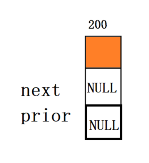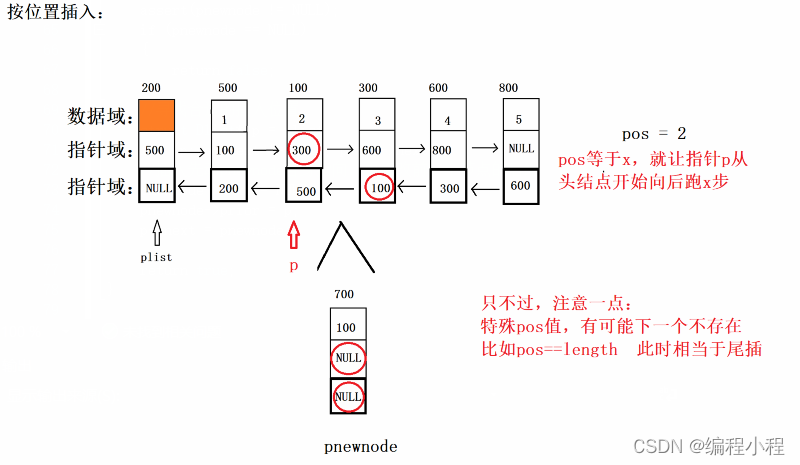双向链表:相比于单链表,双向链表有两个指针域,既可以保存右边的节点地址(后继),也可以保存左边的节点地址(前驱)。如果指针域指向一个不存在的节点,则将其指针置为NULL。
。
如果一个空的双向链表,则它的next和prior同时指向NULL即可。

双向链表结构体设计:
typedef int ELEM_TYPE;
typedef struct Dlist
{
ELEM_TYPE data;//数据域 保存有效值
struct Dlist* next;//指针域 保存下一个节点的地址(后继)
struct Dlist* prior;//指针域 保存上一个节点的地址(前驱)
}Dlist, * PDlist;双向链表主要实现的函数功能方法:
?1.头插

?双向链表的头插需要首先改变新节点pnewnode自身两条线的指向,然后修改后一个节点的前驱,在修改前一个节点的后继。
bool Insert_head(PDlist plist, ELEM_TYPE val)
{
//判空
assert(plist != NULL);
if (plist == NULL)
{
return false;
}
//购买新节点
struct Dlist* pnewnode = BuyNode(val);
//插入 首先修改pnewnode的指向,其次修改后一个节点前驱和前一个节点后继
pnewnode->next = plist->next;
pnewnode->prior = plist;
if (plist->next != NULL)
{
plist->next->prior = pnewnode;
}
plist->next = pnewnode;
return true;
}2.尾插
 ?
?
//尾插
bool Insert_tail(PDlist plist, ELEM_TYPE val)
{
//判空
assert(plist != NULL);
if (plist == NULL)
{
return false;
}
//购买新节点一个
struct Dlist* pnewnode = BuyNode(val);
assert(pnewnode != NULL);
if (pnewnode == NULL)
{
return false;
}
//寻找合适的插入位置
struct Dlist* p = plist;
for (p; p->next != NULL; p = p->next);
//插入先动pnewnode自身指向,再修改前一个节点的后继
pnewnode->next = NULL;
pnewnode->prior = p;
p->next = pnewnode;
return true;
}?
?
?3.按位置插入

?
bool Insert_pos(PDlist plist, int pos, ELEM_TYPE val)
{
assert(plist != NULL);
//购买新节点
PDlist pnewnode = BuyNode(val);
//寻找合适插入位置
PDlist p = plist;
for (int i = 0; i < pos; i++)
{
p = p->next;
}
pnewnode->next = p->next;
pnewnode->prior = p;
if (pos != Get_length(plist) && !IsEmpty(plist)) //排除尾插和头插的风险
{
p->next->prior = pnewnode;
}
p->next = pnewnode;
}4.头删
 ?
?
?
?先用一个临时指针p指向待删除节点位置,在修改后一个节点的前驱和前一个节点的后继,最后释放指针p
bool Del_head(PDlist plist)
{
assert(plist != NULL);
if (plist == NULL)
{
return false;
}
if (IsEmpty(plist)) //判断是否为空链表
{
return false;
}
//寻找待删除节点位置
struct Dlist* p = plist->next;
plist->next = p->next;
if (p->next != NULL)
{
p->next->prior = plist;
}
free(p);
return true;?注:删除一定要判断是否为空链表
5.按位置删除

用一个指针p指向待删除节点位置,用另一个临时指针q指向待删除节点的前一个节点的地址
?修改待删除节点后一个节点的前驱和待删除节点前一个节点的后继,最后释放p
bool Del_pos(PDlist plist, int pos)
{
assert(plist != NULL);
if (plist == NULL)
{
return false;
}
assert(pos >= 0 && pos <= Get_length(plist));
if (pos == 0)
{
return Del_head;
}
if (pos == Get_length(plist))
{
return Del_tail;
}
//判断是否空链表
if (IsEmpty(plist))
{
return false;
}
//寻找待删除节点位置
struct Dlist* q = plist;
for (int i = 0; i < pos; i++)
{
q = q->next;
}
struct Dlist* p = q->next;
q->next = p->next;
p->next->prior = q;
free(p);
return true;
}双向链表实现完整代码:
Dlist.h
#pragma once
//双向链表结构体设计:
typedef int ELEM_TYPE;
typedef struct Dlist
{
ELEM_TYPE data;//数据域 保存有效值
struct Dlist* next;//指针域 保存下一个节点的地址(后继)
struct Dlist* prior;//指针域 保存上一个节点的地址(前驱)
}Dlist, * PDlist;
//双向链表可执行函数声明:
//初始化
void Init_dlist(struct Dlist* plist);
//购买新节点
struct Dlist* BuyNode(ELEM_TYPE val);
//头插
bool Insert_head(PDlist plist, ELEM_TYPE val);
//尾插
bool Insert_tail(PDlist plist, ELEM_TYPE val);
//按位置插
bool Insert_pos(PDlist plist, int pos, ELEM_TYPE val);
//头删
bool Del_head(PDlist plist);
//尾删
bool Del_tail(PDlist plist);
//按位置删
bool Del_pos(PDlist plist, int pos);
//按值删除
bool Del_val(PDlist plist, ELEM_TYPE val);
//查找(如果值重复,返回第一次出现的节点地址)
struct Dlist* Search(PDlist plist, ELEM_TYPE val);
//判空
bool IsEmpty(PDlist plist);
//判满(链表不用实现)
//获取有效长度
int Get_length(PDlist plist);
//清空
void Clear(PDlist plist);
//销毁1
void Destroy(PDlist plist);
//销毁2
void Destroy2(PDlist plist);
//打印
void Show(PDlist plist);
Dlist.cpp
#include <stdio.h>
#include <assert.h>
#include <malloc.h>
#include "dlist.h"
//初始化
void Init_dlist(struct Dlist* plist) //排除两个野指针的风险
{
plist->next = NULL;
plist->prior = NULL;
}
//购买新节点
struct Dlist* BuyNode(ELEM_TYPE val)
{
struct Dlist* pnewnode = (struct Dlist*)malloc(1 * sizeof(struct Dlist*));
assert(pnewnode != NULL);
if (pnewnode == NULL)
{
return NULL;
}
pnewnode->data = val;
pnewnode->next->prior = NULL;
return pnewnode;
}
//头插
bool Insert_head(PDlist plist, ELEM_TYPE val)
{
//判空
assert(plist != NULL);
if (plist == NULL)
{
return false;
}
//购买新节点
struct Dlist* pnewnode = BuyNode(val);
//插入 首先修改pnewnode的指向,其次修改后一个节点前驱和前一个节点后继
pnewnode->next = plist->next;
pnewnode->prior = plist;
if (plist->next != NULL)
{
plist->next->prior = pnewnode;
}
plist->next = pnewnode;
return true;
}
//尾插
bool Insert_tail(PDlist plist, ELEM_TYPE val)
{
//判空
assert(plist != NULL);
if (plist == NULL)
{
return false;
}
//购买新节点一个
struct Dlist* pnewnode = BuyNode(val);
assert(pnewnode != NULL);
if (pnewnode == NULL)
{
return false;
}
//寻找合适的插入位置
struct Dlist* p = plist;
for (p; p->next != NULL; p = p->next);
//插入先动pnewnode自身指向,再修改前一个节点的后继
pnewnode->next = NULL;
pnewnode->prior = p;
p->next = pnewnode;
return true;
}
//按位置插
bool Insert_pos(PDlist plist, int pos, ELEM_TYPE val)
{
assert(plist != NULL);
if (plist == NULL)
{
return false;
}
assert(pos >= 0 && pos <= Get_length(plist));
if (pos == 0)
{
return Insert_head(plist, val);
}
else if (pos == Get_length(plist))
{
return Insert_tail(plist, val);
}
//购买新节点
PDlist pnewnode = BuyNode(val);
//寻找合适插入位置
PDlist p = plist;
for (int i = 0; i < pos; i++)
{
p = p->next;
}
pnewnode->next = p->next;
pnewnode->prior = p;
if (pos != Get_length(plist) && !IsEmpty(plist)) //排除尾插和头插的风险
{
p->next->prior = pnewnode;
}
p->next = pnewnode;
}
//头删
bool Del_head(PDlist plist)
{
assert(plist != NULL);
if (plist == NULL)
{
return false;
}
if (IsEmpty(plist)) //判断是否为空链表
{
return false;
}
//寻找待删除节点位置
struct Dlist* p = plist->next;
plist->next = p->next;
if (p->next != NULL)
{
p->next->prior = plist;
}
//释放p
free(p);
return true;
}
//尾删
bool Del_tail(PDlist plist)
{
assert(plist != NULL);
if (plist == NULL)
{
return false;
}
if (IsEmpty(plist))
{
return false;
}
struct Dlist* p = plist;
for (p; p->next != NULL; p = p->next);
free(p);
}
//按位置删
bool Del_pos(PDlist plist, int pos)
{
assert(plist != NULL);
if (plist == NULL)
{
return false;
}
assert(pos >= 0 && pos <= Get_length(plist));
if (pos == 0)
{
return Del_head;
}
if (pos == Get_length(plist))
{
return Del_tail;
}
//判断是否空链表
if (IsEmpty(plist))
{
return false;
}
//寻找待删除节点位置
struct Dlist* q = plist;
for (int i = 0; i < pos; i++)
{
q = q->next;
}
struct Dlist* p = q->next;
q->next = p->next;
p->next->prior = q;
free(p);
return true;
}
//按值删除
bool Del_val(PDlist plist, ELEM_TYPE val)
{
assert(plist != NULL);
if (plist == NULL)
{
return false;
}
struct Dlist* p = Search(plist, val);
if (p == NULL)
{
return false;
}
//在申请一个指针q,指向p的前一个节点
struct Dlist* q = plist;
for (q; q->next != p; q = q->next);
//此时 q在p前面
//跨越指向 + 释放内存
q->next = p->next; //ok
if (p->next != NULL)
{
p->next->prior = q;//特殊情况:如果你找的val值 在尾结点找到了 这行代码就会失败
}
free(p);
return true;
}
//查找(如果值重复,返回第一次出现的节点地址)
struct Dlist* Search(PDlist plist, ELEM_TYPE val)
{
assert(plist != NULL);
if (plist == NULL)
{
return false;
}
for (struct Dlist* p = plist->next; p != NULL; p = p->next)
{
if (p->data == val)
{
return p;
}
}
return NULL;
}
//判空
bool IsEmpty(PDlist plist)
{
return plist->next == NULL;
}
//判满(链表不用实现)
//获取有效长度
int Get_length(PDlist plist)
{
assert(plist != NULL);
if (plist == NULL)
{
return false;
}
int count = 0;
for (struct Dlist* p = plist->next; p != NULL; p = p->next)
{
count++;
}
return count;
}
//清空
void Clear(PDlist plist)
{
Destroy(plist);
}
//销毁1
void Destroy(PDlist plist)
{
assert(plist != NULL);
if (plist == NULL)
{
return ;
}
while (plist->next != NULL)
{
struct Dlist* p = plist->next;
plist->next = p->next;//这里只需要上一个节点 指向下一个节点即可
free(p);
}
plist->next = plist->prior = NULL;
}
//销毁2
void Destroy2(PDlist plist)
{
assert(plist != NULL);
if (plist == NULL)
{
return ;
}
struct Dlist* p = plist->next;
struct Dlist* q = NULL;
plist->next = plist->prior = NULL;
while (p != NULL)
{
q = p->next;
free(p);
p = q;
}
}
//打印
void Show(PDlist plist)
{
assert(plist != NULL);
if (plist == NULL)
{
return ;
}
for (struct Dlist* p = plist->next; p != NULL; p = p->next)
{
printf("%d ", p->data);
}
printf("\n");
}